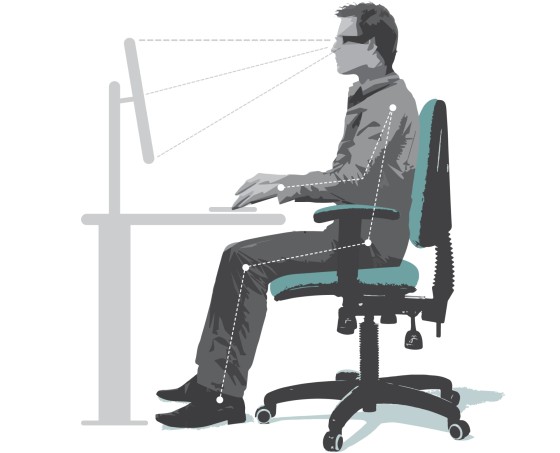Recommended sitting posture
If you’re a computer-user sitting for extended periods of time, understanding the basics of positive sitting posture can make a huge difference to your comfort and energy levels, your productivity, and your long-term health.
Here is a checklist you can take yourself through, to make sure you’re sitting positively.
Elbows by your side and level with keyboard
To be able to use the computer comfortably for extended periods of time, you need to be able to use your keyboard and mouse without stretching.
Stretching or over-reaching while using the computer can cause forearm and shoulder tension and pain.
Your shoulders should be relaxed, and your elbows close by your side and approximately level with your keyboard.
If you’re reaching up, or wrists are rolled back, you’ll quickly experience wrist strain, pain and fatigue.
Eyes level with the top of your screen
To protect your neck and shoulder muscles from strain and pain your eyes should be approximately level with the top of your screen.
Back properly supported
If you’re sitting for some hours at a time our recommendation is that as a minimum your chair should have gaslift seat height adjustment, and backrest angle and height adjustment.
Always sit near the back of your seat. Make sure the chair backrest is adequately supporting your back and allowing you to sit with your back straight. The backrest lumbar support should be positioned to support your lower back.
We recommend sitting with your torso and thighs at an angle a little more open than 90 degrees, with your knees slightly lower than your hips. This open-angle sitting position allows for good circulation and lung function.
Feet flat on the floor
Your feet should be flat on the floor or on a footrest. If your feet aren’t reaching the floor or somehow supported, there’s likely to be pressure under your thighs which can inhibit circulation and cause discomfort or cramp.
CHANGE POSTURE REGULARLY
Any prolonged sitting position, even a good one, can be tiring. As you’re working you can change your chair backrest angle or seat angle from time to time to allow your spine and muscles a variation in position.
Health professionals recommend that we stand up or move away from our seated position at least once every hour. If you have a height-adjustable desk you can alternate sitting and standing throughout the day.
Adjustment instructions for each of our task chairs can be found on our chair range pages, and you can learn more on our Chair Mechanisms page.
Print this page as a pdf.

